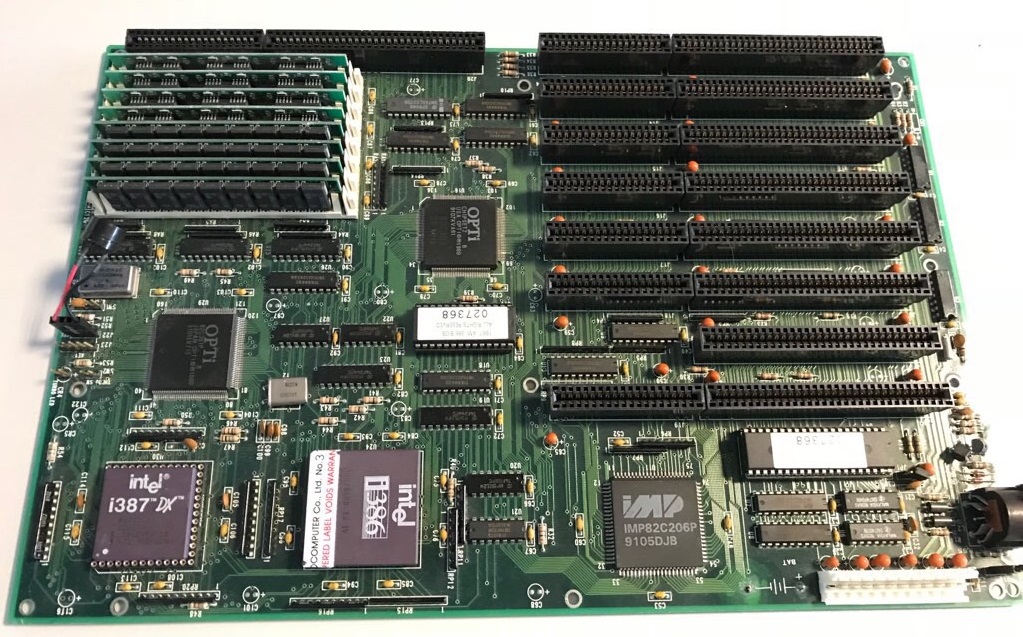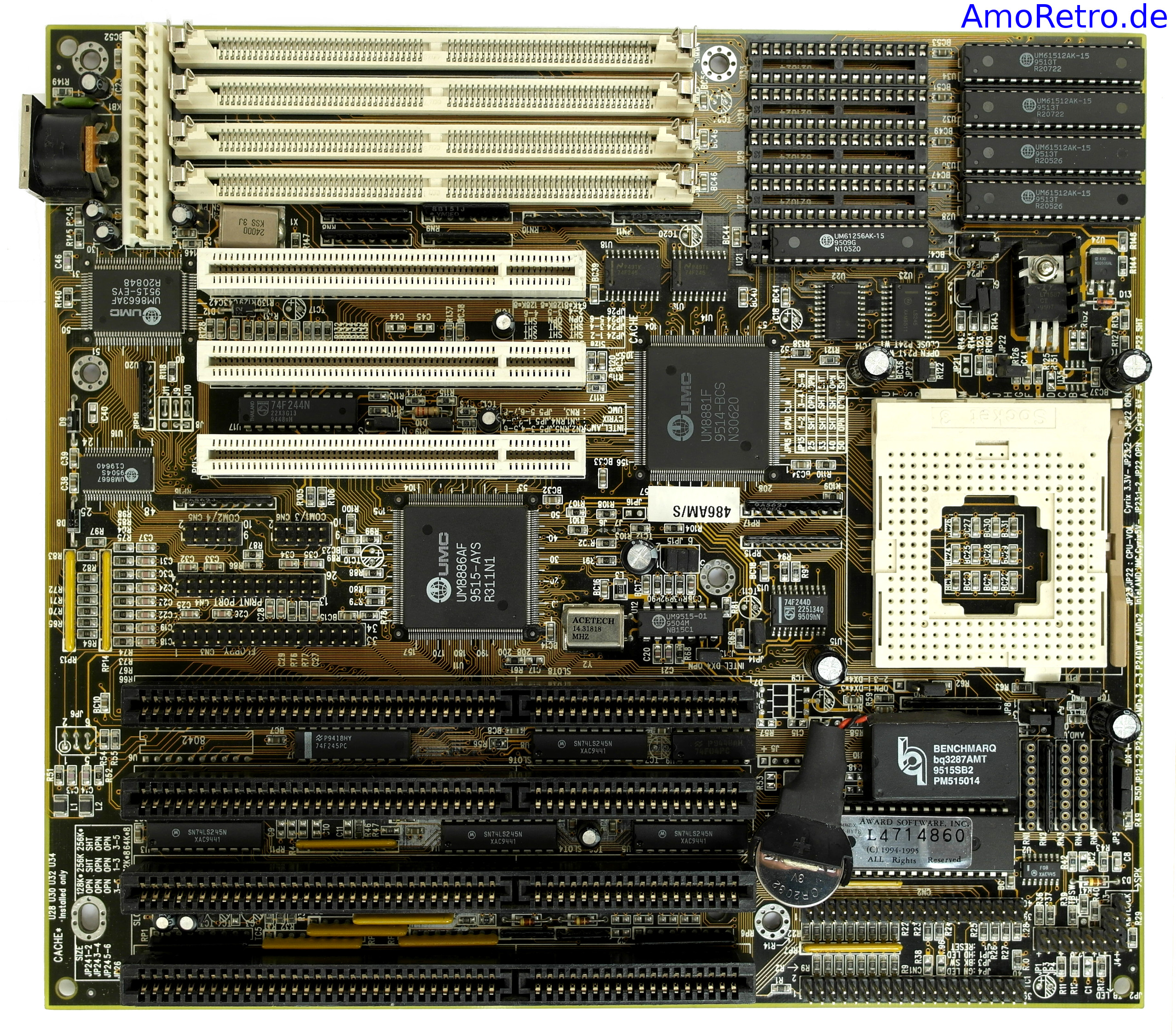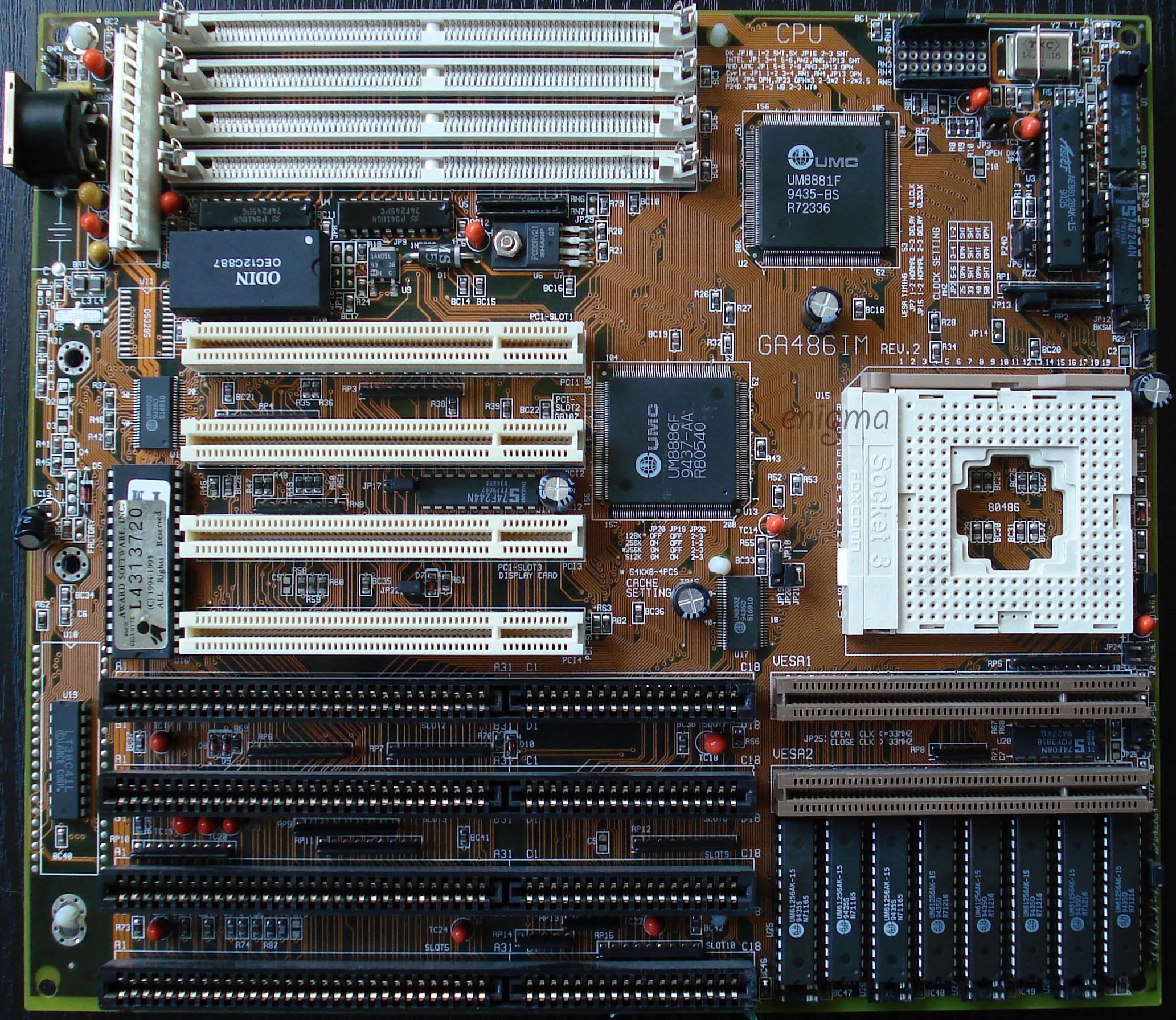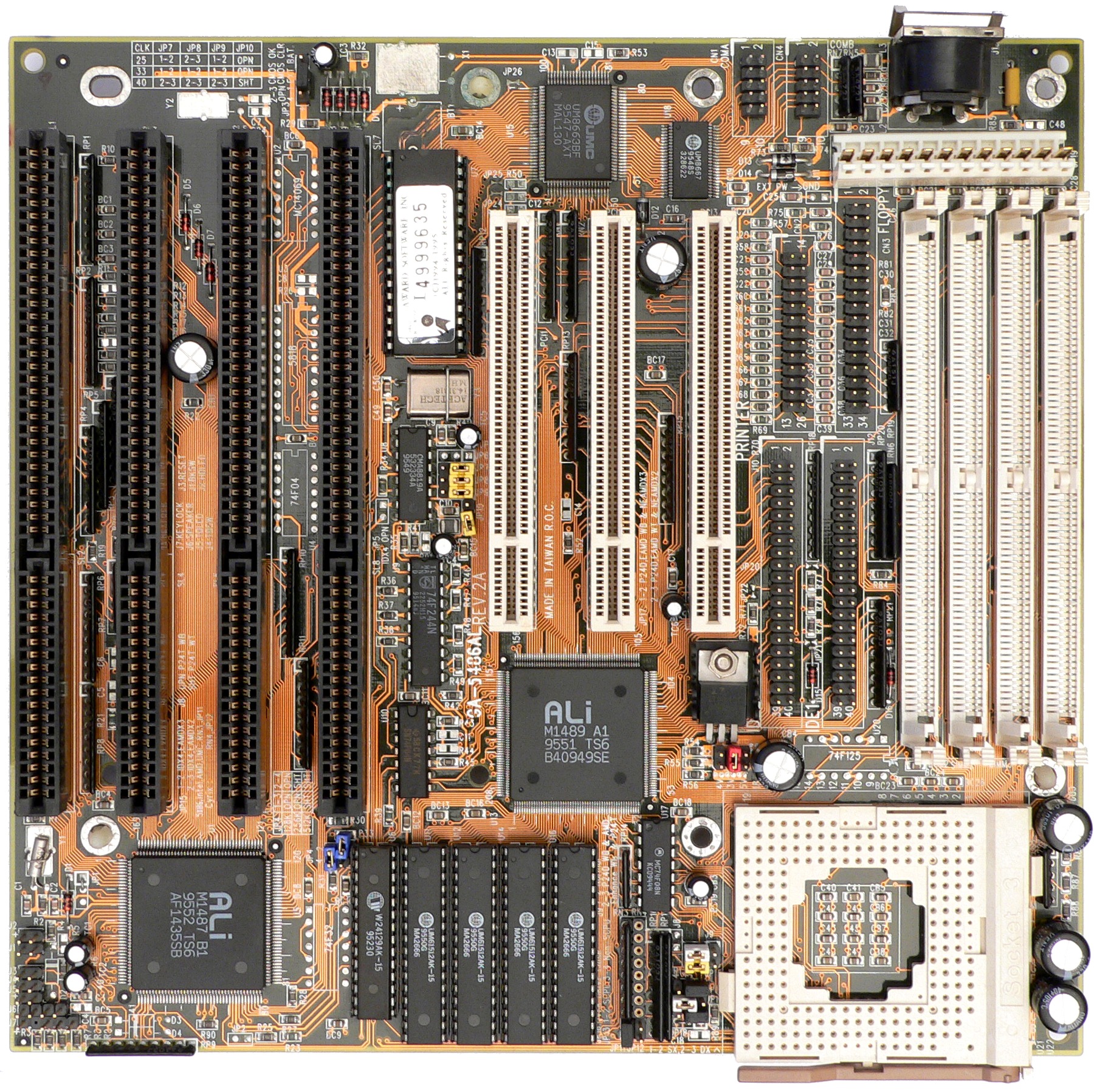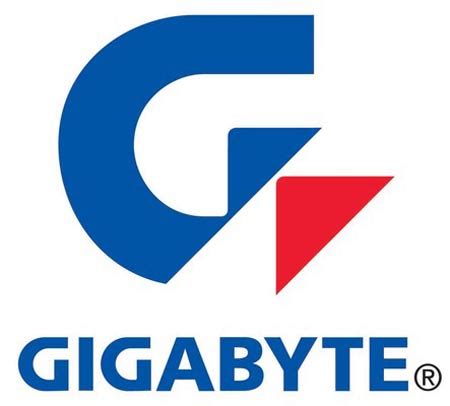 Gigabyte Technology Co., Ltd
Gigabyte Technology Co., Ltd
Founded in 1986, Taiwanese tech company Gigabyte was one of the more prominent motherboard manufacturers for the IBM PC and its compatibles during the DOS era. They are known for their high performance, stability, and depending on CPU era, for decent overclocking options.
GA-306
|
||||||
GA-386
|
||||||
GA-386PS
|
||||||
GA-486AM/S
|
||||||
GA-486IM
|
||||||
GA-486VS / GA-486VF
|
||||||
GA-5486AL
|
| Hercules Dynamite 128 | - |
| Matrox Millennium (MGA2064) | 32 MB/sec |
| Elsa Winner 1000 (S3 Trio64V+) | 33 MB/sec |
GA-5AX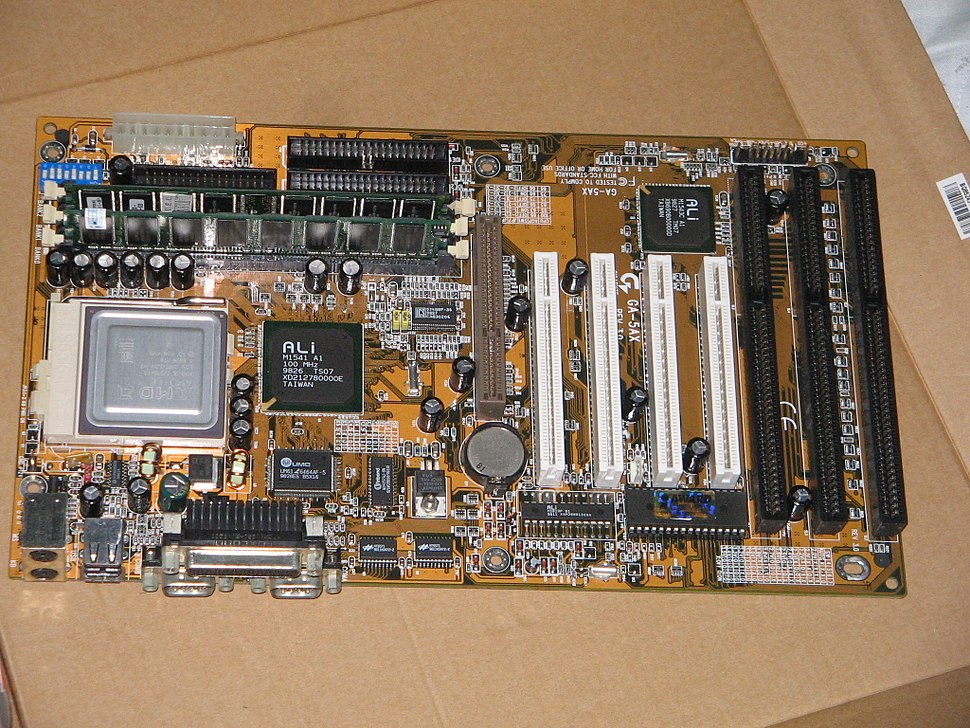
Year: 1998
Type: Super Socket 7
Form Factor: ATX (300mm x 180mm), 4-layer
Power Connector: ATX
Chipset: ALi Aladdin V
Slots: ISA (2 or 3 x 16-bit), AGP, PCI (4 or 5) - see notes
Memory: 168-pin DIMM (3 banks) - ECC supported. Max 768MB
BIOS: Award (1 Mbit flash)
Latest BIOS Version: F4
Known Board Revisions: 1.0, 3.0, 4.1, 5.2
One of the best Super Socket 7 motherboards ever. The GA-5AX was a similar board spec-wise to the Asus P5A, but The GA-5AX didn't suffer from stability problems above 500 MHz that the Asus did.
Supported CPUs are Intel Pentium 100-200 MHz, Pentium MMX 166-233 MHz, AMD K5 PR133 and PR166, AMD K6 166-300, AMD K6-2 300, AMD K6-3 400, AMD K6-2+ and K6-3+, Cyrix/IBM 6x86 (CPU date code must be after 605) PR166, Cyrix 6x86 MX PR166-PR266, Cyrix MII PR300, and IDT C6 200-266. CPU voltages range from 2.0V up to 3.5V, although by default the BIOS auto-detects the CPU and sets the correct voltage accordingly.
FSB speeds range from 66 MHz up to 100 MHz on a Rev 3.0 board or up to 140 MHz on Rev 4.1 and later.
Core multipliers available are 1.5x, 2x, 2.5x, 3x, 3.5x, 4x, 4.5x, 5x and 5.5x on Rev 4.1 and lower, and up to 6.5x on Rev 5.2. Note, however, that the Aladdin V chipset does not permit decoupling the FSB from the other buses so they must all run at the same speed as what you set the FSB to - this can lead to stability problems with some cards when going over 100 MHz.
512 KB L2 cache onboard. The AGP slot on this board is 2x, so supports all AGP 1x and AGP 2x graphics cards. The board has two USB slots on the back panel, PS/2 keyboard and mouse sockets, two 9-pin serial ports and 1 parallel port.
The two IDE channels (supporting up to 4 drives) can run hard disks up to ATA/66.
Board revisions 4.1 and 5.2 have 5 PCI slots and 2 ISA slots. Older revisions have 4 PCI slots and 3 ISA.
The key difference between board revision 4.1 and 5.2 is that v4.1 got the ALi M1541/1543 "A1" revision, while the later v5.2 board got M1451 "B1".
Typical period hardware used with this motherboard were: Fast AMD K6-2, K6-2+ and K6-III processors, sticks of double-sided PC133 SDRAM, nVidia TNT2 or GeForce 256, or from ATI their Rage 128GL or Rage 128 Pro (Fury). Going slightly ahead of this era, fitting an nVidia GeForce 2 GTS/Pro/Ultra/Ti is a great stable option.
User manual
BIOS update: F4 (19 Sep 2000) - Added support for AMD K6 '+' CPUs.
GA-586AL/AP
Year: 1994
Type: Socket 4
Form Factor: 3/4 Baby AT
Chipset: ALi M1489
Slots: 4 x ISA (16-bit), 3 x PCI
Memory: 3 x 72-pin SIMM, Max. 160 MB (FPM only).
BIOS: Award v4.51PG
BIOS Versions: AL=2.01 AP=1.63
BIOS Strings:
05/20/96-ALI-1487/89-2A4KDG09C-00
Known Board Revisions: 2A, 2S
CPU support: Intel Pentium 60 or 66 (P5T).
This board comes with either 256 KB, 512 KB or 1 MB of L2 cache.
GA-586AM
Year: 1995
Type:
Form Factor:
Chipset:
Slots:
Memory:
BIOS Dates: 1207 is dated 12/07/1995
BIOS Versions: 1207
Known Board Revisions:
GA-586AS
Year: ?
Type:
Form Factor:
Chipset:
Slots:
Memory:
BIOS:
BIOS Versions: 1.41
Known Board Revisions:
GA-586AT/x
Year: ?
Type:
Form Factor:
Chipset:
Slots:
Memory:
BIOS:
BIOS Versions: 2.12
Known Board Revisions:
GA-586ATE/P
Year: ?
Type: Socket 7
Form Factor: ?
Chipset: ?
Slots:
Memory:
BIOS: Award
BIOS Dates: 02/08/96
BIOS Versions: 2.25 2.30
Known Revisions: 4.0
This board supports the Cyrix 6x86 P120+ CPU.
BIOS Revisions:
- 2.25 (unknown benefits)
- 2.30 corrected ID problem with Pentium 120 OverDrive "POVP" CPU
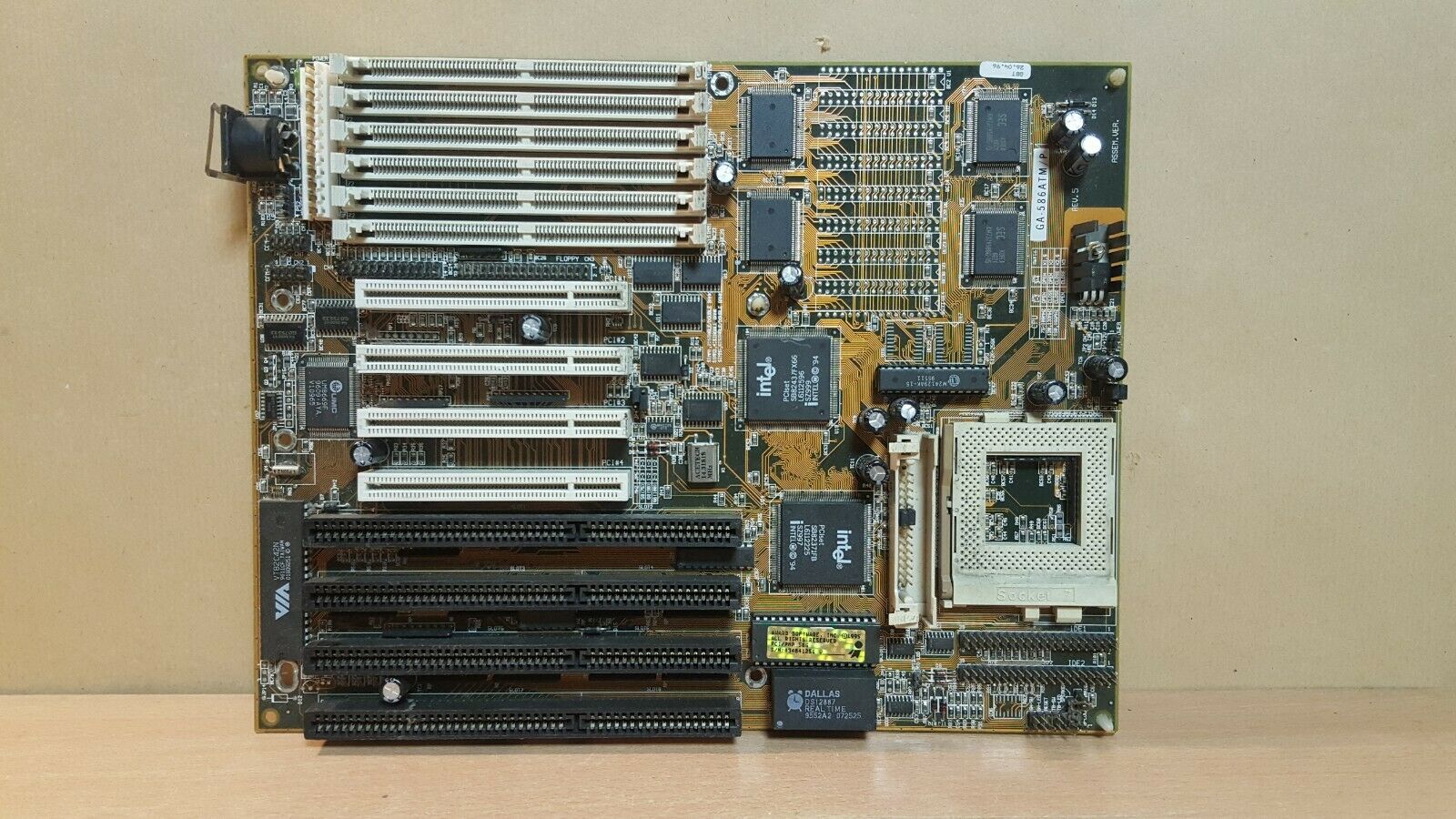 GA-586ATM/P
GA-586ATM/P
Year: 1995
Type: Socket 7
Form Factor: Baby AT
Chipset: Intel 430FX
Slots: 4 x ISA, 4 x PCI
Memory: 6 x 72-pin SIMM slots (3 banks)
BIOS: Award
BIOS Dates: 02/02/96
BIOS Versions: 3.26 3.31 *WARNING: Flash your BIOS at your own risk. I am not responsible for the content of these files*
Known Board Revisions: 5.0
This board supports the Cyrix 6x86 P120+, P150+ and P166+ CPUs.
BIOS Revisions:
- 3.26 (unknown benefits)
- 3.31 updated the BIOS to Award v4.51PG with new PnP
GA-586ATS
Year: ?
Type: Socket 7
Form Factor: ?
Chipset: ?
Slots:
Memory:
BIOS: Award
BIOS Dates: 02/01/96
BIOS Versions: 1.30
Known Revisions: 2C, 2D
This board supports the Cyrix 6x86 P120+ up to P166+ CPUs.
BIOS Revisions:
- 1.30 updated the BIOS to Award v4.51PG with new PnP
GA-586ATV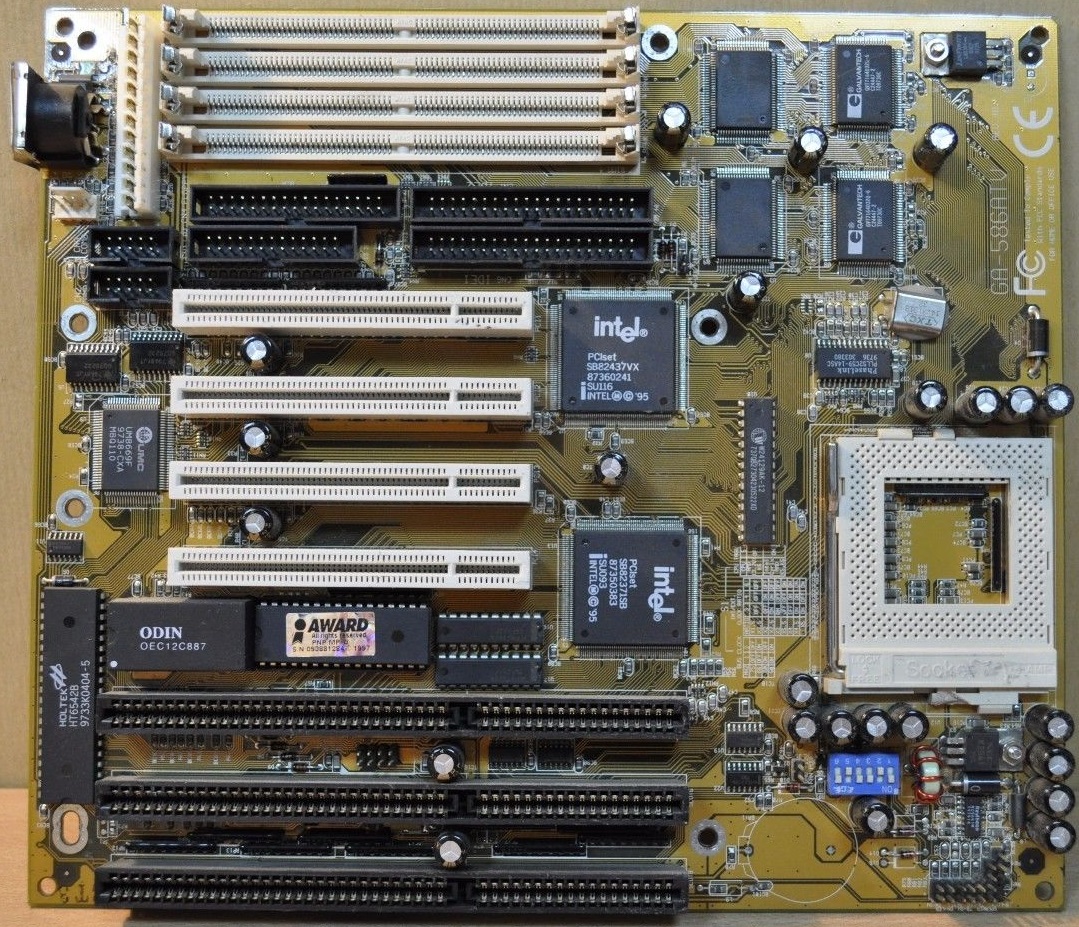
Year: 1996
Type: Socket 7
Form Factor: ATX
Chipset: Intel 430VX
Slots: ISA (3 x 16-bit), PCI (4)
Memory: 72-pin SIMM (4 banks)
BIOS: Award
BIOS Dates: 05/15/96
BIOS Versions: 1.13
Known Board Revisions: 1A
This board supports the Cyrix 6x86 P120+ up to P166+ CPUs.
BIOS Binary (Unknown Version)
BIOS Revisions:
- 1.13 corrected the ID for AMD K5 and upgraded AMP to 1.2
GA-586AVS
Year: ?
Type:
Form Factor:
Chipset: SiS 5511/5512
Slots:
Memory:
BIOS:
BIOS Versions: 1.04
Known Board Revisions:
GA-586HX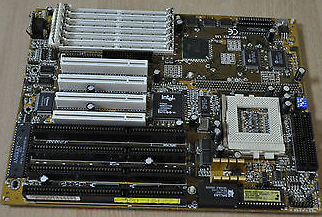
Year: ?
Type: Super Socket 7
Form Factor: ATX
Chipset: Intel
Slots: ISA (4 x 16-bit), PCI (4)
Memory: 72-pin SIMM (6 banks)
BIOS: Award
BIOS Versions: 1.05 1.07 1.11 2.3 2.5 AF
Known Board Revisions: 1.55
BIOS Revisions:
- 1.05 provided a new Award BIOS v4.51PG with new PnP
- 1.07 fixed a compatibility problem between EMM386 and PnP ICU, fixed a problem with Mode 3 Floppy support, corrected the ID for the AMD K5, and upgraded AMP to 1.2.
- 1.11 fixed a floppy problem when running under Windows 3.11 with an ISA VGA card, and with DOS prompt open.
GA-586ID/IM
Year: ?
Type:
Form Factor:
Chipset:
Slots:
Memory:
BIOS:
BIOS Versions: 586ID: 2.6 2.7 3.5, 586IM: 3.9 4.2 4.4L
Known GA-586ID Board Revisions: STD Rev 1, STD Rev 2, Advanced Rev 1, Advanced Rev 2, Rev 3
The ID board came in standard revision 1 and 2, and advanced revision 1 and 2.
ID BIOS Revisions:
- 2.6 is for Standard revision 1 and 2 GA-586ID boards only
- 2.7 is for Advanced revision 1 and 2 GA-586ID boards only
- 3.5 is for revision 3 boards only
IM BIOS Revisions:
- 3.9 (unknown benefits)
- 4.2 (unknown benefits)
- 4.4L is for Advanced revision boards only
GA-586IP/IS
Year: ?
Type:
Form Factor:
Chipset:
Slots:
Memory:
BIOS:
BIOS Versions: 1.8 1.9 2.0 3.4 (IS only)
Known Board Revisions: Standard (STD), Advanced
BIOS Revisions:
- GA-586IP v1.8 is to be used with 586IP STD boards only
- GA-586IP v1.9L is to be used with 586IP Advanced boards only
- GA-586IP v2.0 is to be used with 586IP STD boards only. This updated the BIOS to Award v4.51PG
- GA-586IS v3.4 - (unknown benefits)
GA-586S2 MMX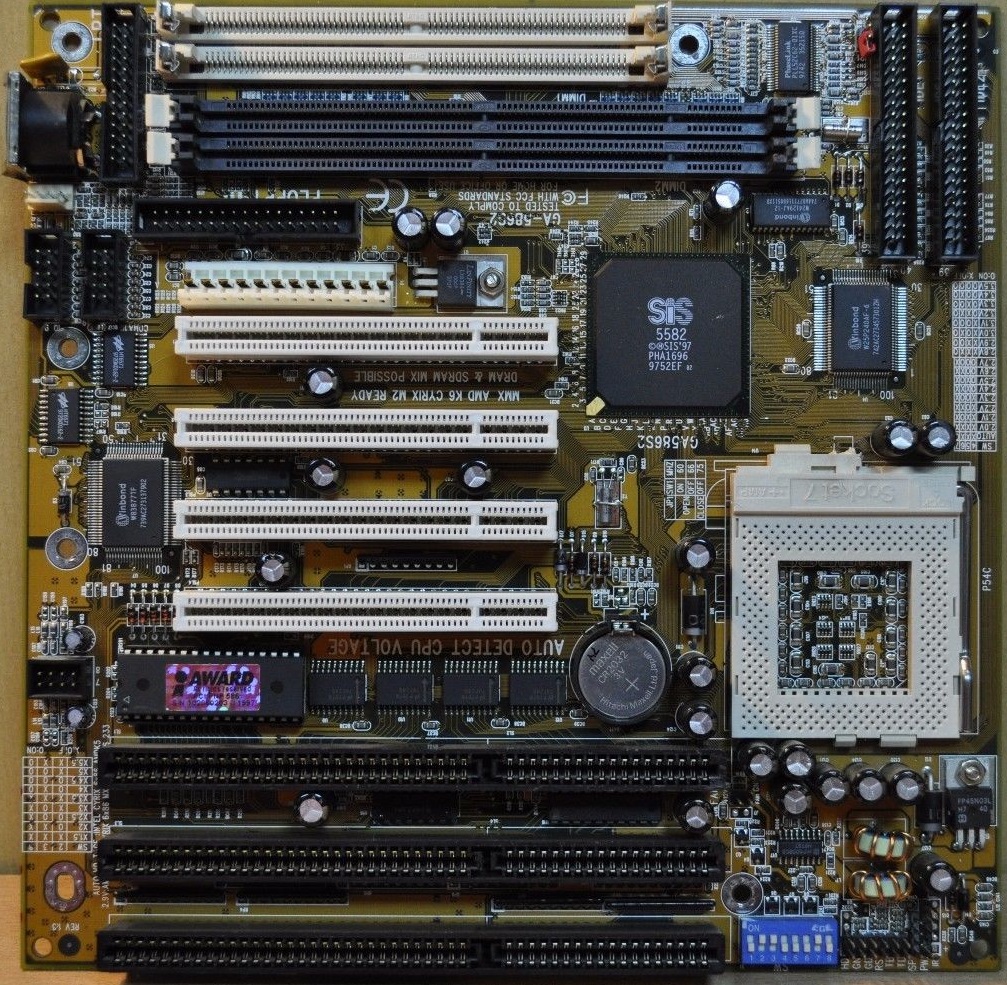
Year: ?
Type: Socket 7
Form Factor: ATX
Chipset: SiS 5582
Slots: ISA (3 x 16-bit), PCI (4)
Memory: 72-pin SIMM (2 banks), 168-pin DIMM (2 banks).
BIOS: Award
Known Revisions: 1A
Supports Intel, AMD K6 and Cyrix MII CPUs. The board is able to auto-detect the CPU voltage.
GA-586SG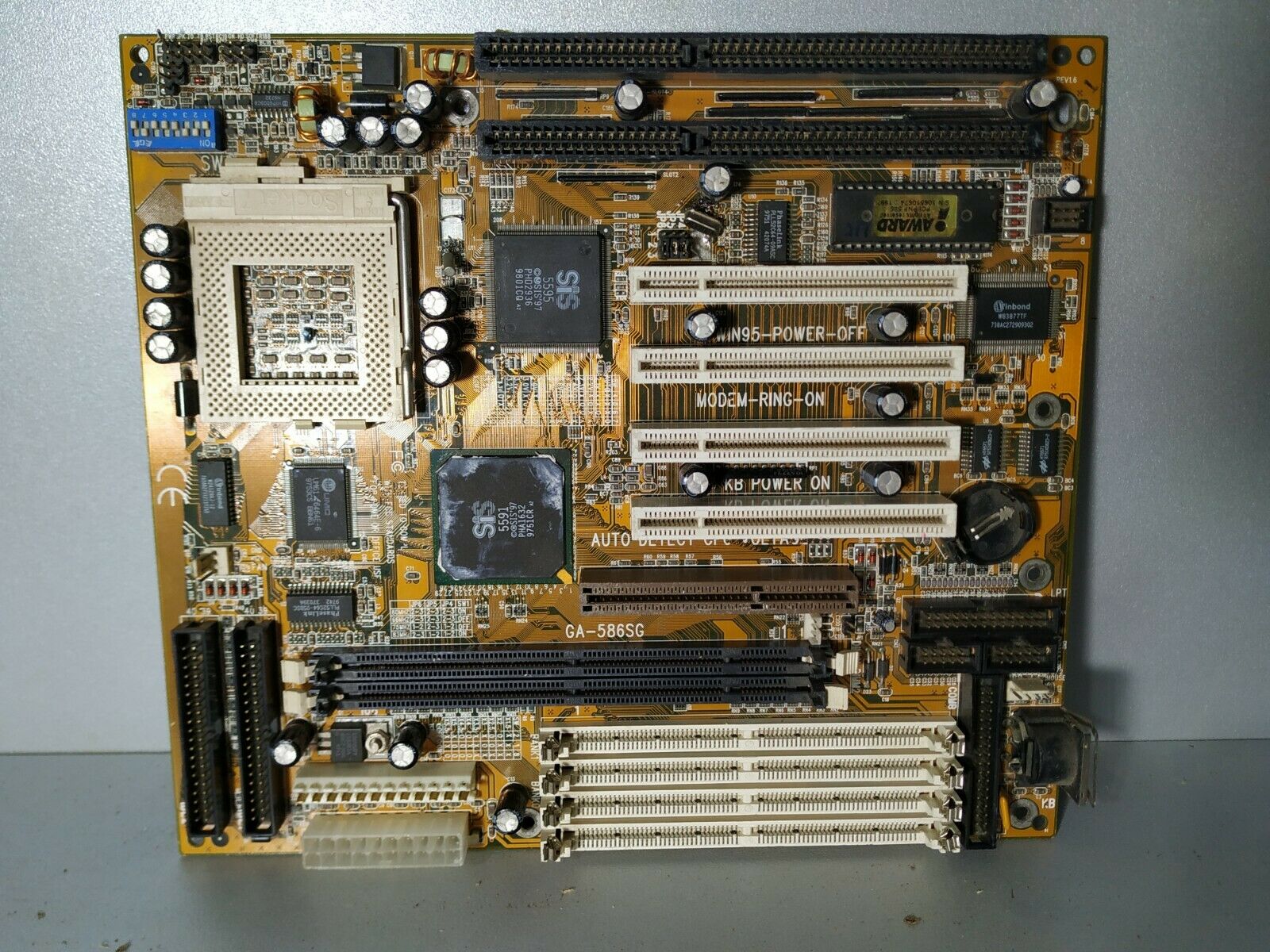
Year: ?
Type: Socket 7
Form Factor: ATX
Chipset: SiS 5591/95
Slots: ISA (2 x 16-bit), PCI (4), AGP
Memory: 72-pin SIMM (4 banks), 168-pin DIMM (2 banks).
Power Socket: AT (P8/P9) and ATX
BIOS: Award
Known Revisions: 1.15, 1.6
GA-586STX and STX2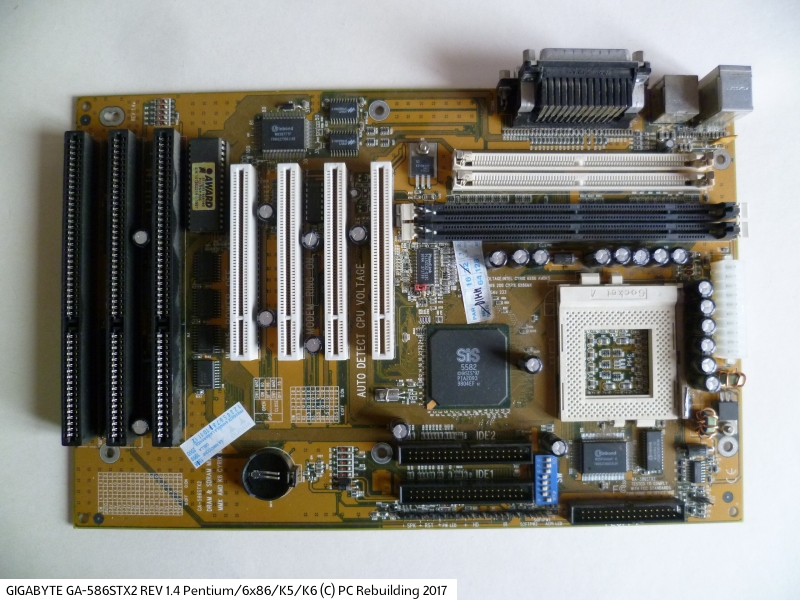
Year: 1997
Type: Socket 7
Form Factor: ATX
Chipset: SiS 5581/82
Slots: 3 x ISA (16-bit), 4 x PCI
Memory: 2 x 72-pin SIMM (1 bank), 2 x 168-pin DIMM, 384 MB max.
BIOS: Award 4.51PG
Known Board Revisions: 1A, 1.4
512 KB L2 cache onboard. COAST slot for cache expansion.
CPU clock speeds from 75 MHz up to 400+ MHz, with clock multipliers from 1.5x up to 5.5x.
Bus speeds are 60, 66 or 75 MHz.
With a bios update (available on support http://www.gigabyte.com.au/Motherboard/GA-586STX2#support-dl) the motherboard should also support the 400MHz AMD K6-2: 66Mz bus and core multiplier remap 2.0x = 6.0x
GA-586SVX
Year: ?
Type:
Form Factor:
Chipset:
Slots:
Memory:
BIOS:
BIOS Versions: 1.03 1.04
Known Board Revisions:
BIOS Revisions:
- 1.03 corrected the ID for AMD K5 and upgraded AMP to 1.2
- 1.04 fixed a floppy problem under Windows 3.11 with an ISA VGA card and DOS prompt open.
GA-586T2
Year: ?
Type:
Slots:
Form Factor:
Chipset:
Memory:
BIOS:
BIOS Versions: 1.7
Known Board Revisions:
 GA-586TX3
GA-586TX3
Year: ?
Type:
Slots:
Form Factor:
Chipset:
Memory:
BIOS:
BIOS Versions:
Known Board Revisions:
GA-586VX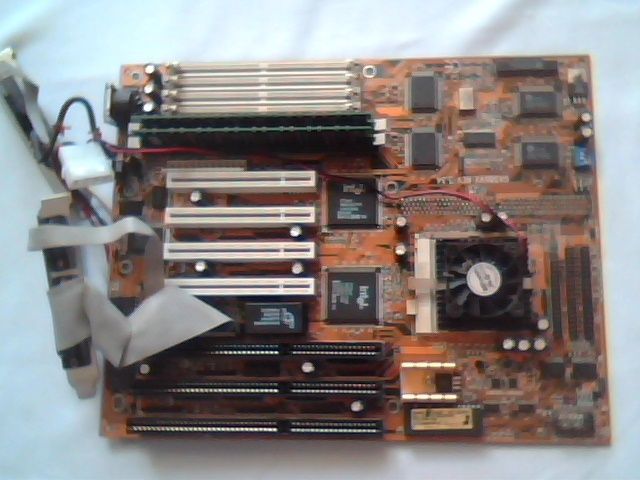
Year: ?
Type: Super Socket 7
Form Factor: ATX
Chipset: Intel 430VX Triton III
Slots: ISA (3 x 16-bit), PCI (4)
Memory: 72-pin SIMM (4 banks)
BIOS: Award
BIOS Versions: 1.03 1.04
Known Revisions: 3.34
BIOS Revisions:
- 1.03 corrected the ID for AMD K5 and upgraded AMP to 1.2
- 1.04 fixed a floppy problem under Windows 3.11 with an ISA VGA card and DOS prompt open.
GA-686BX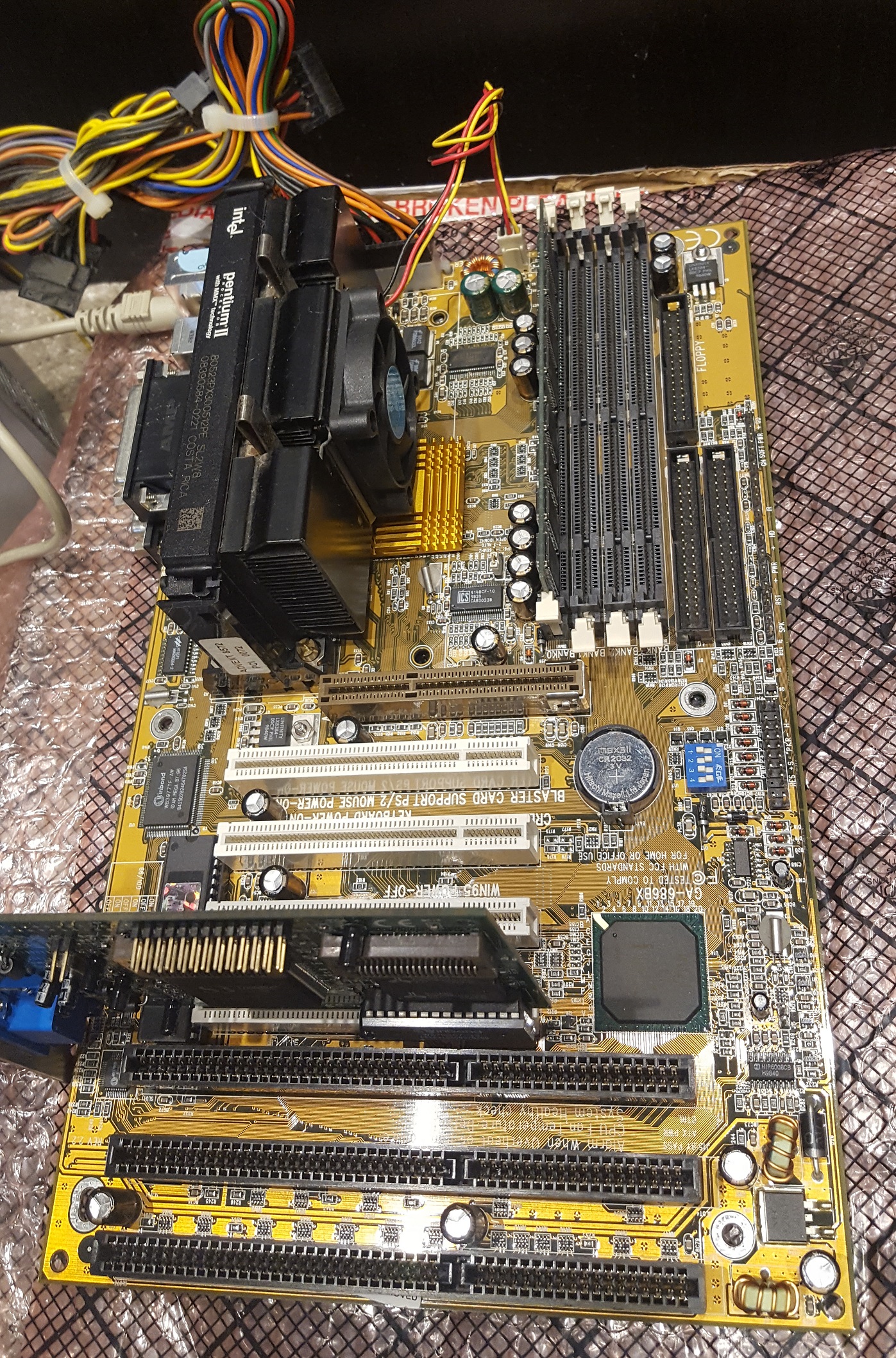
Year: 1998
Type: Slot 1
Form Factor: ATX
Chipset: Intel 440BX
Slots: ISA (3), PCI (4), AGP 2x
Memory: 4 banks of 168-pin DIMM (up to 1 GB)
BIOS: Award v4.51PG
Known Board Revisions: 1.0, 2.0, 2.2
One of Gigabyte's first Slot 1 mainboards, and its first to use the 440BX chipset, the GA-686BX has a good combination of features, including support for EDO and non-EDO SDRAM, a Creative SB-Link header (designed to link a sound card running on your PCI bus to the mainboard [DMA and IRQ] to allow PCI sound cards to work under DOS "real mode"), and runs a 100 MHz Front Side Bus.
It was designed to drive the Pentium II CPU ranging from 233 MHz up to 550 MHz, but later BIOS revisions extended this support to include Intel Pentium III “Katmai” (2.0V) 450 or “Coppermine” up to 600 MHz, and Intel Celeron “Mendocino".
Around the time of the Pentium II, overclocking was being reigned in by Intel, with all chips from Katmai and upcoming socketed Celerons having overclock protection built-in to the chip. Multiplier locks were already prevalent, but this new technology would have the CPU check the front side bus, and if it exceeded the limit for that CPU, the CPU would not run. As such, there is little to no overclocking tweaks you can do with this board. There's a selection jumper for 66 or 100 MHz FSB, and four DIP switches to select the clock multiplier, ranging from 3x up to 5.5x. This means it can support CPU speeds from 200 MHz (66 MHz FSB x 3x multiplier) up to 550 MHz (100 MHz FSB x 5.5x multiplier). There is no CPU voltage adjustment in any BIOS revision. The BIOS does have a lot of memory performance tweaks you can make, however. Strangely, I put a Pentium III 800 MHz into this board with BIOS version F2A, and it worked! It just ran it at 600 MHz.
Overall, the combination of AGP 2x, PCI and ISA slots mean this board is a nice one to use for retro DOS and Windows 95/98 gaming, and with the latest BIOS version (F2A dated 25th April 2001), gives a performance range equivalent to a Super Socket 7 PC running an AMD K6/233 up to a K6-2/450.
